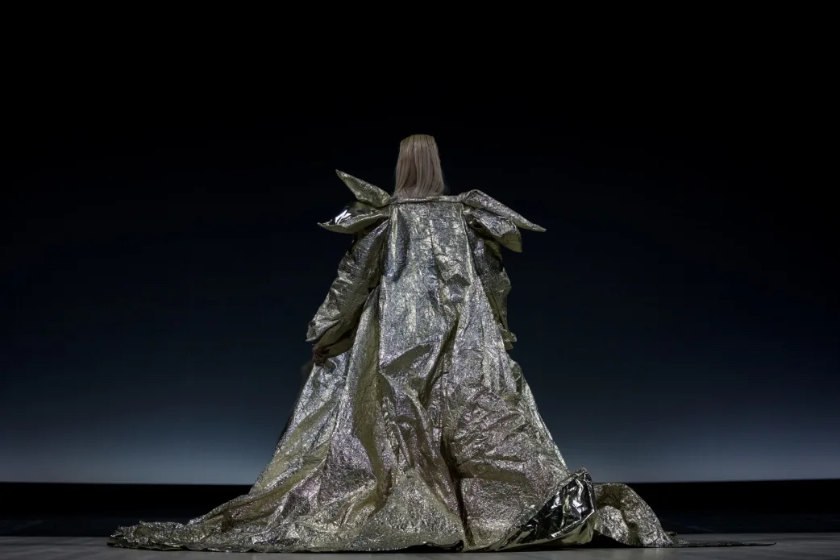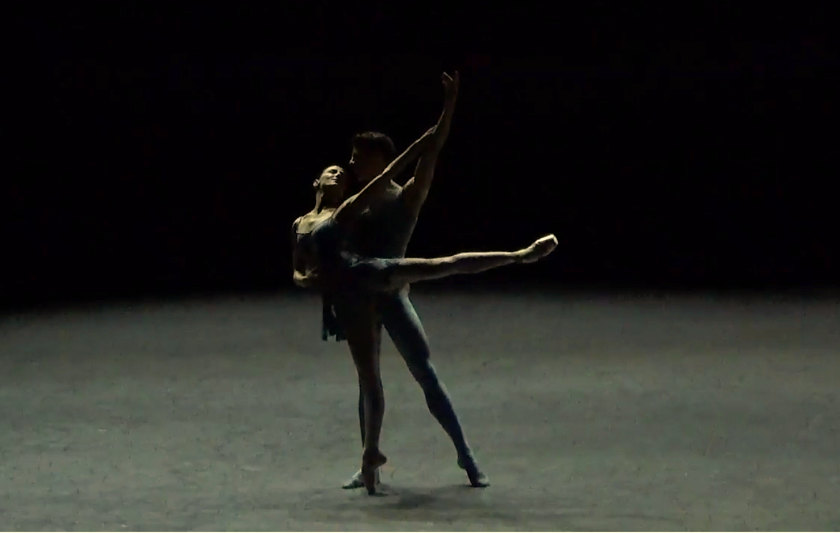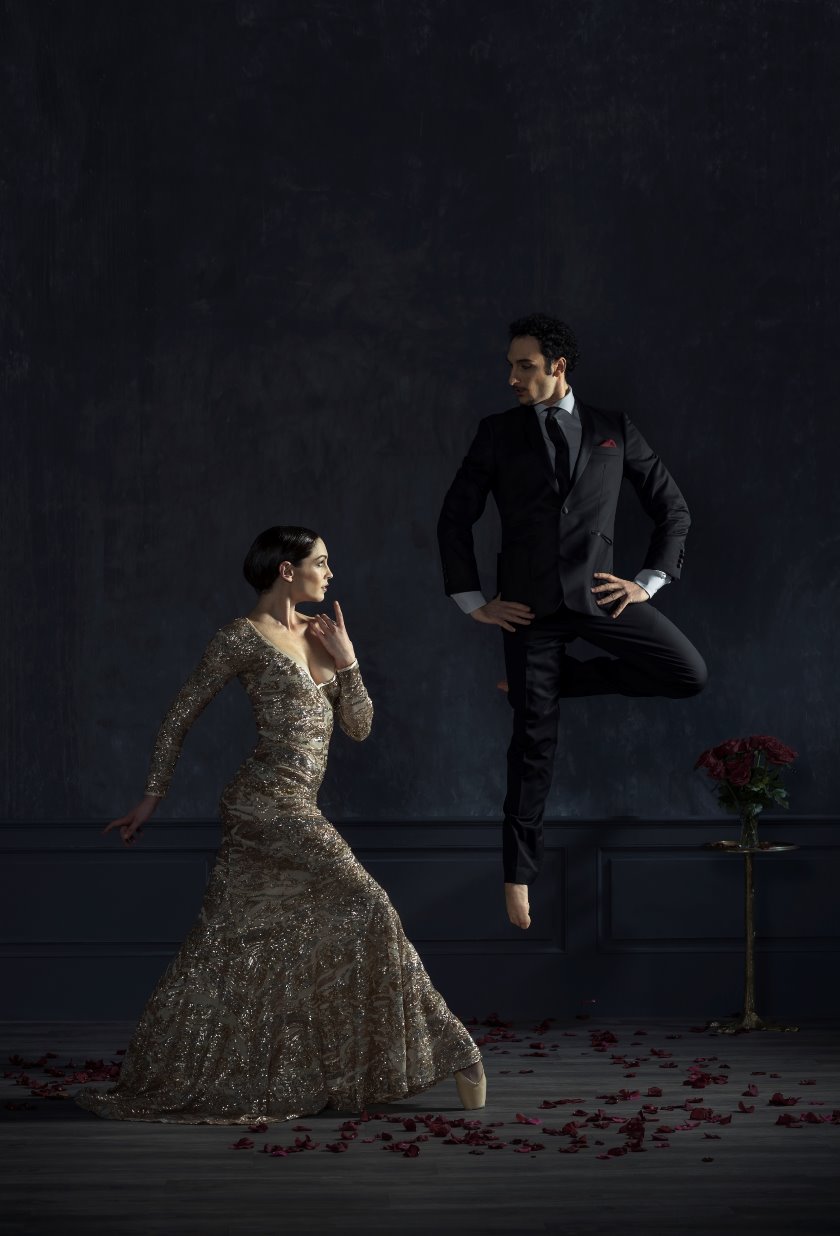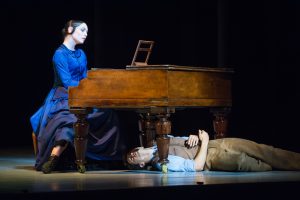

Kirstin O’Brien
Above, from top: Interior staircase at the Palais Garnier. The Palais Garnier’s façade. The author admiring the beauty of the Golden Room. Below right: The author on the balcony at the Palais Garnier.
 When one of the world’s most respected ballet companies collaborates with artistic geniuses from the arts, fashion and music creatives, you can only assume you will be left breathless.
When one of the world’s most respected ballet companies collaborates with artistic geniuses from the arts, fashion and music creatives, you can only assume you will be left breathless.
The Paris Opéra Ballet did just that when they danced two works at the Palais Garnier on October 2: both creative for different reasons but equally poignant in their production quality and performance.
Setting the scene, which certainly demands respect, the Palais Garnier in Paris is undoubtably one of the most beautiful theatres in the world.
The exterior staircase runs the length of the building and wraps around the edges allowing the theatregoer to make a graceful entrance from any angle.
The façade, featuring illuminated statues of artistic “royalty”, is majestic and the golden, winged heralds of chorégraphie and poesie lyrique glow atop the magnificent exterior.
Once inside, the grand marble staircase leads up and outwards right and left to the mezzanine where you can sip your champagne and wait for the performance to begin. The elegant poise and low-talking ballet audience add a serenity to the marble columns, balconies, chandeliers and frescoed ceilings.
While waiting, there is one place which must be visited—the Grand Foyer or ‘Golden Room’—which was created by Charles Garnier, the architect of Palais Garnier. His intention was for this room to be a place to ‘rest, stroll and mingle with high society’. It is connected to the most prestigious part of the theatre and is decorated by paintings by Paul Baudry.
The Golden Room gives the Hall of Mirrors at Versailles a contender for its opulence and beauty. The entire 154 m long, 18 m high foyer is golden-hued and sumptuously decorated in gilt columns, frescoes, statues and golden chandeliers which hang low down the length of the space, casting their light on the shining parquet floor.
Arriving early to the performance gives the added privilege of being in this glorious room with only a handful of others, making the experience even more astonishing.


Kirstin O’Brien
Above, from top: Champagne prior to the performance. Marc Chagall’s frescoed ceiling inside the Palais Garnier theatre.
After sipping champagne (and discreetly taking photographs), it is time to enter the Palais Garnier theatre.
The interior of the theatre is richly decorated in dark red velvet, golden balconies and the famous ceiling painted by Marc Chagall. The giant chandelier which hangs from his colourful work brings his dancing figures to life.
Finally, time for the ballet!
East meets west
Hiroshi Sugimoto: At the Hawk’s Well (choreographed by Alessio Silvestrin)
Paris Opéra Ballet, Palais Garnier, October 2, 2019
The curtain was already up for the Hiroshi Sugimoto work and the audience allowed a preview of a pale, T-shaped wooden stage set slightly elevated from the main stage.
The chandelier dimmed and the audience hushed. Hiroshi Sugimoto’s At the Hawk’s Well was about to start.
From the outset this was positioned to be an artistic, contemporary piece due to Sugimoto’s visual artistry. Yet it also references two art forms from history. Sugimoto’s aim, to bring the spirit of the Celtic playwright W. B. Yeats on to the stage by re-enacting his play At the Hawk’s Well and combining it with the ancient form of Japanese Noh theatre, is inspired. Just as Yeats honoured the form of Noh theatre with this play in 1916, Sugimoto wished to honour Yeats for his preservation of ancient Japanese theatre.
W. B. Yeats’s story is one which still shows the profundity of human nature today: it is of an old man who has waited fifty years by a well on an isolated island guarded by a spirit–Hawk, in the hope of drinking its elusive, preserving waters. Whenever the well rises up, the Hawk dances and lulls the old man to sleep. The Young Man (depicting the hero Cuchulain from Yeats’s play) is warned of the perils of this entrancement (both of the water and the Hawk). Yet the themes of immortality, rationality and impulse prevail, just as they do today.
Sugimoto’s scene was darkroom photographic in nature: a dark blue-black set with the empty wooden stage and the shadows of dancers moving behind the cyc.
The Old Man, performed with intensity and technical skill by Audric Bezard, entered the stage from the left wearing a floor-length muted silver, extravagant cape, long silver wig and beard. His precise, thoughtful movements were mesmerizing, with the only sound coming from the rustle of his costume (designed by none other than fashion designer Rick Owens).
The movements had a Japanese quality—they were considered, calm and, at the same time, profound: exaggerated by the dancer’s physique being covered only with a loincloth and calf-length silver boots under the rustling cape. Bezard’s artistry was emphasized by every sinew of his body.


Ann Ray
Above, from top: Audric Beard, Paris Opéra Ballet. Hugo Marchand in the role of the Young Man, wearing Rick Owens, Paris Opéra Ballet.
The symbolism was sensory: from the dull light of the costume, the contemplative movement in the choreography of his arms, to the white horizontal light depicting the horizon and highlighting his isolation on the well’s island.
These visual cues were accompanied by the sounds of electronic feedback interspersed with deep bass notes which gradually built in volume. This was an original score by electronic composer and visual artist Ryoji Ikeda and the sounds imparted their presence to the performance on stage. The Old Man’s futile pursuit of drinking the waters of the well weighed heavily in this opening scene.
The Young Man, danced with strength and grace by Axel Magliano, entered from the right totally obscured by his floor-length shiny gold cape, which he held high and then gradually emerged from behind with his movements. The sound of the two dancers’ capes moving with the crackle of feedback gave off a static electricity.
They disrobe and dance a pas de deux on the wooden stage. Sugimoto’s use of lighting and Silvestrin’s interpretive choreography, and the artistry of these two outstanding dancers brought the dialogue to life. The tension between the two was one of conflict and sympathy. With a single spotlight they danced in and out of the light.
The set then dramatically changed to a deep red lighting and an intense, deep droning soundtrack as the Hawk entered, danced by the impeccable Amandine Albisson. She was wearing a Rick Owen’s costume with 2 m wings (yes, over 4 m wingspan). She stepped into the middle of the stage and postulated with her wings: one side then the other.
This mesmerized the Old and Young Men and, after helping her remove her wings, they seated themselves either side of the wooden stage. She emerged from her wings wearing a cutout red leotard, a long red wig and calf high red shiny pointe boots. Her extensions and strength were powerful to watch and both the characters on stage and the audience were spellbound.

Ann Ray
Above and below right: Danseuse Étoile Amandine Albisson of Paris Opéra Ballet performing Hawk in Hiroshi Sugimoto’s At the Hawk’s Well, choreographed by Alessio Silvestrin.

Ann Ray
The story unfolds as the Young Man danced a beautiful pas de deux with the Hawk before her assistants come back on stage to prevent him from drinking from the well.
Fully winged, her assistants triumphantly lift the Hawk up into the centre of the stage with the set lighting changing from intense red on top underlined with deep blue (reminiscent of a Rothco painting) and then the colours seep downwards like a setting sun as they carry her away.
The final scenes juxtapose theatre and ballet as Sugimoto delves into the story with traditional Noh theatre – this was challenging for the audience but was what Sugimoto intended: The Noh actor creating the inertia required to let the audience ponder the themes of immortality, heroism and age while contextually summoning the spirit of W.B. Yeats. The Noh actor walked slowly towards the seated Young Man: his intermittent heavy footfall the only sound. Tension built as the hushed audience watched this slow exchange between the supernatural being and the Young Man. The Noh actor finally stamped his foot loudly rousing the audience back to the stage and handed the Young Man his walking stick.
Sugimoto’s masterful vision of visual arts, lighting design and direction with the sublime choreography of Allesio Silvestrin culminated in enthusiastic applause for his first ballet creation.


Ann Ray

Above, from top: Danseuse étoile Amandine Albisson of Paris Opéra Ballet performing Hawk in Hiroshi Sugimoto’s At the Hawk’s Well, choreographed by Alessio Silvestrin. Noh performer and the Young Man. Curtain call, At the Hawk’s Well cast, Palais Garnier, October 2, 2019.
Stretching boundaries

Ann Ray
Above: Paris Opéra Ballet’s danseur étoile Hugo Marchand rehearsing William Forsythe’s Blake Works 1.
William Forsythe: Blake Works 1
Paris Opéra Ballet, Palais Garnier, October 2, 2019
American-born William Forsythe’s international renown as a leading choreographer of ballet is superbly showcased with his seven pieces in Blake Works 1, performed by the Paris Opéra Ballet at the Palais Garnier in 2019.
Forsythe captures the essence from the lyrics of singer–songwriter James Blake’s album The Colour in Anything (2016) in his seven beautifully staged works. His choreography is balletic, energetic, complex and mesmerizing, the dancers showing their technique, fluidity and tremendous strength under Forsythe’s incredible vision and expertise in choreographic direction.
Pairing this exploration of conventional ballet alongside the soulful, poetic music of James Blake is inspired: both choreographer and composer have classical learnings yet add their own twist to the conventional whilst still honouring the heritage of their genres.
Forsythe’s signature style is evident. While maintaining a a tight core of ballet steps within the choreography, he also pushes these talented, classically trained Paris Opéra Ballet dancers to stretch the boundaries of traditional ballet: an extension of weight off the centre so partners pull away from each other creating balance; luxuriously over-extended penché arabesque lines; broken wrist lines; grand jetés ending with the dancer stopping and casually walking to the back of the stage as if in rehearsal. This over-extension of form was heightened further with the use of full port-de-bras and multiple turns, creating a fluidity of movement and grandness to the works.
The inspiration behind the choreography are Blake’s soulful lyrics. The songs are both haunting and joyous: either a layering of James Blake’s voice as a composition of echoey choir parts over a low-vibe synthesizer with a quick-paced metronome beat (‘Put That Away’, and ‘I Hope My Life’); a solo voice over a ghosty organ electronic keyboard (‘Waves Know Shores’) or with single piano chords and heart-aching lyrics as in his ‘The Colour in Anything’ and ‘Forever’.
The precision of the company’s balletic movements to a contemporary beat was extraordinary. A pas de trois danced to ‘Put That Away’ by Silvia Saint-Martin, Camille Bon and Antoine Kirsher involved very quick combinations of steps, yet was elegantly danced with extended poses that allowed breath between the movements.
Léonore Baulac and Florent Melac captured the waves of a relationship’s emotional depths with their performance to ‘The Colour in Anything’.


Ann Ray
Above, from top: A pas de deux in Blake Works 1. The corps de ballet. Below right: Paris Opéra Ballet’s danseur étoile showing his dramatic ballon.

Ann Ray
Reminiscent of Balanchine, Forsythe had his corps de ballet dance in straight-lined synchronicity behind the leads, who surprised the traditional form by dancing subtly different sequences but, at the same time, adding a richness of movement and direction on the stage—and a visual break for the audience.
A pas de quatre performed by four of the company’s danseurs étoiles and premiers danseurs was powerful, graceful and showed their effortless ballon while in the air.
With so much artistry to take in, William Forsythe kept the costumes and lighting for these seven works to a minimum: monochrome pale grey–blue leotards, and skirts with a slightly darker background lighting. The audience was able to focus on the artists at work: the stars of the Paris Opéra Ballet performing such a tightly choreographed work and the music which filled up the theatre and the soul.
At times, the performance was so perfect that the audience was left to wonder who was performing to whom: the music and dancers’ movements breathlessly continuous.
Blake Works 1 was a seamless integration of two talented artists and the extraordinary dancers whose own world-class artistry brought the composer’s and choreographer’s work to life.
The final pas de deux danced by Hohyun Kang—the epitome of panache—and Florent Melac to Blake’s ‘Forever’ expressed a growing love between the dancers’ characters to such intensity that I was moved to tears. It was achingly beautiful and a tremendous finale piece which captured the audience’s hearts forever.—Kirstin O’Brien


Julien Benhamou
Above, from top: Germain Louvet and Ludmila Pagliero’s pas de deux moment in William Forsythe’s Blake Works 1. Paris Opéra Ballet’s danseuse étoile Ludmila Pagliero.









